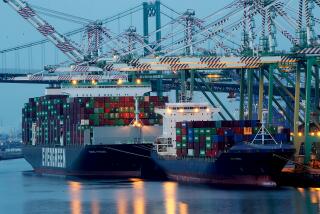Hueneme Port to Be Home of Oil Spill Center : Environment: A consortium plans to spend $60 million to make the site the first of five regional facilities capable of cleaning up a major leak.
The deep-water Port of Hueneme, long overshadowed by other commercial shipping ports, is poised to become one of the nation’s leading centers for the cleanup of major oil spills.
A consortium of big oil companies plans to pour $60 million into the Port of Hueneme to make it the first of five regional centers capable of handling a 216,000-barrel oil spill, about the amount that leaked from the Exxon Valdez in Alaska last year.
“The Port of Hueneme center will be the first to come on line, and it will be a training facility for the rest of the country,” said Skip Onstad, the newly appointed general manager of the Pacific Southwest Regional Response Center.
In addition to the economic boost to the port, the regional response center provides an extra layer of protection for the Ventura County and Santa Barbara County coastlines, which have a majority of California’s offshore oil drilling.
Any spills in the area from offshore oil rigs or tankers now would be handled by ships and equipment of Clean Seas, an oil cleanup cooperative. Based in Carpinteria, the cleanup team was formed by area oil companies after the 1969 Union Oil platform blowout off Santa Barbara.
Placing the regional response center in Port Hueneme would greatly bolster the area’s fleet of oil cleanup vessels, equipment and personnel needed in the event of a catastrophic spill, industry experts said.
“It certainly should enhance the ability to handle emergencies, such as a calamity in the Santa Barbara Channel,” said Dorill B. Wright, mayor of the city of Port Hueneme and a California coastal commissioner.
“With the Mideast crisis, more oil exploration will probably take place in the Santa Barbara Channel,” said Edward J. Millan, president of the Port of Hueneme’s harbor commissioners. “We hope an accident never happens, but if it does, it is good to have the capability of this magnitude close by.”
Despite the industry effort, critics are skeptical about handling moderate spills, not to mention one as large as the 11 million gallons of crude oil that poured from the Exxon Valdez into Alaska’s Prince William Sound in March, 1989.
Brian Baird, the California Coastal Commission’s oil spill cleanup specialist, said he is pleased that the industry is making an effort. But he said today’s technology is too primitive to prevent a large spill from fouling the shore.
“We are going to have to clean it up when it hits the beach,” Baird said. “But, hopefully, we will be able to keep more oil off the beach.”
One of the main reasons for selecting the Port of Hueneme is its proximity to oil drilling in the Santa Barbara Channel, said John Dowling, a Chevron U.S.A. official involved in the site selection. The port also has the advantage of being next to two naval bases that could lend support, such as airlifting people and equipment, he said.
In addition, the Port of Hueneme is less congested than other deep-water ports of Los Angeles and Long Beach--contenders in the yearlong search for a site.
“The Port of Hueneme does not have all of the hustle and bustle that is around Los Angeles and Long Beach,” Wright said. “It’s minutes from the harbor to the high seas, where it may take a few hours to get through the harbor in Long Beach.”
The regional center at the Port of Hueneme is one of five proposed centers that would be run by the Marine Spill Response Corp., a new nonprofit organization established by 20 major oil companies and shippers.
The corporation plans to spend $800 million over the next five years to develop around-the-clock response teams. The program is designed to fill a need outlined last year by an oil industry study, which said that “neither the government nor the industry has the equipment or personnel in place and ready to deal with catastrophic spills.”
Seattle will have the only other regional center on the West Coast. The other three will be at Lake Charles, La., New York and Port Everglades, Fla.
All five centers are expected to be operational within the next 2 1/2 years. The Port of Hueneme center may come on line within 18 months.
Unlike the other centers, the Port of Hueneme already has available warehouse space, offices, berths and other structures needed for a regional center, Dowling said.
Dowling and Onstad entered into negotiations last week with Port of Hueneme officials over the price of leasing a 92,000-square-foot building, three acres of staging area and berths for several vessels.
Anthony J. Taormina, the port’s executive director, declined to discuss the negotiations. “All I can say is we don’t have a contract yet.”
But Dowling said he sees no problems in reaching an agreement with port authorities. “I’ve been told to close the deal by the end of the month,” Dowling said. “We want Port Hueneme to be up and running and fly the colors for the organization.”
The Marine Spill Response Corp. plans to place $27.4 million worth of equipment at the port, including a 200-foot oil recovery vessel and at least one barge capable of storing 20,000 to 50,000 barrels of recovered oil.
The center also would have a variety of smaller boats, equipment to skim oil off the surface of water, floating booms to contain spills, beach protection equipment and a stockpile of chemicals to disperse oil.
Smaller amounts of equipment would be stored at other locations within the Pacific Southwest region, including the ports of San Francisco, Los Angeles/Long Beach, San Diego and Oahu, Hawaii.
Once operational, the center at Port Hueneme would employ about 60 people, with rotating crews prepared to depart at any hour. It is unclear how many others would be employed to handle training for the centers in other regions.
“The equipment in the region will give us a major start in combating a spill the size of the Exxon Valdez,” Onstad said.
Until accepting his new position, Onstad had been manager of Clean Seas, the local oil spill cleanup cooperative that has three large oil recovery vessels and equipment stored in various places to cover spills off of Ventura, Santa Barbara and San Luis Obispo counties.
Onstad said Clean Seas will remain an independent organization with the primary responsibility of handling smaller spills. “Clean Seas is the largest and best-equipped of the co-ops in the country,” he said. “It can handle a spill of large significance.”
More to Read
Sign up for Essential California
The most important California stories and recommendations in your inbox every morning.
You may occasionally receive promotional content from the Los Angeles Times.










